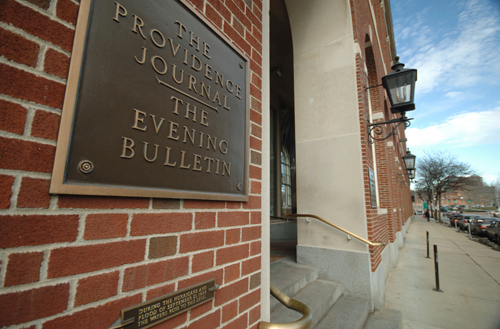
(Updated, 11:15 a.m.)
PROVIDENCE – The Providence Journal’s weekday circulation fell 18.8 percent compared with last year in the six-month period ended Sept. 30 as the paper lost nearly 25,000 readers, according to figures released Monday by the Audit Bureau of Circulations.
The Journal’s average weekday circulation fell to 106,875 copies, compared with 131,620 as of Sept. 30, 2008. The advertising-heavy Sunday edition sold 154,300 copies, down 17.3 percent from 186,571 in 2008. Saturday circulation sank, too, by 19.4 percent to 139,561.
The Journal said it had a combined print and online readership of 710,135 people in September in the Providence-New Bedford television market defined by Nielsen Media Research. The paper also reported 1.26 million unique visitors to its Web site. The figures in the report are based on publisher’s statements, and eventually will be audited.
Like most newspapers, The Journal’s circulation has been declining for years. In 1989, for example, the paper had 199,507 daily readers. A decade later, the figure was 164,626. The paper also raised prices earlier this year.
The two other newspapers in Rhode Island that disclosed figures were The Pawtucket Times and The Woonsocket Call.
The Times said weekday circulation was 5,616 copies and Saturday circulation was 7,550. The paper changed its reporting basis recently to separate Monday-Friday and Saturday figures, but a year earlier reported an average Monday-Saturday circulation of 6,830.
The Woonsocket Call said Monday-Saturday circulation fell 8.4 percent to 7,391 and Sunday circulation declined 8.3 percent to 10,396 in the six months ended Sept. 30. The Call’s daily readership stood at 17,091 in 1999 and 28,927 a decade before that.
The story was similar in Massachusetts.
The Standard-Times of New Bedford said weekday circulation fell 10 percent to 26,334; Sunday circulation declined 7.1 percent to 28,323; and Saturday circulation slid 8 percent to 26,433 in the six months ended Sept. 30.
The Herald News of Fall River said Monday-Saturday circulation fell 9.1 percent to 16,547 and Sunday circulation declined 6.6 percent to 17,508 in the six months ended Sept. 30. The Herald News had 26,091 daily readers a decade ago.
One local newspaper posted a small increase: The Taunton Gazette said its Sunday circulation increased 2.4 percent to 8,300 copies. The Gazette’s Monday-Saturday circulation fell 9.5 percent to 7,518.
The Sun Chronicle of Attleboro failed to file its circulation numbers before the deadline for the Audit Bureau’s report.
The Boston Globe, which was threatened with closure by parent The New York Times Co. during the reporting period, said weekday circulation fell 18.5 percent to 264,105 and Sunday circulation shrank 16.9 percent to 418,529.
Newspaper circulation is now the lowest it has been since the years before World War II, according to an analysis of the Audit Bureau’s data by Alan D. Mutter, a newspaper industry consultant.
Total U.S. newspaper circulation fell to about 39.1 million in the six months ended Sept. 30, lower than the 41.1 million papers sold in 1940, the earliest date for which the Newspaper Association of America has records, Mutter said. Sunday circulation reached its lowest point since 1945.
Those figures mean only 12.9 percent of the U.S. population bought a paper in 2009, compared with 31.1 percent of the population in 1940.












I will re-subscribe to the ProJo when it is no longer owned by Texans and they improve their journalistic integrity back to the way it was before the Texans bought it. It’s a shame what they did to one of our countries great newspapers just to try to squeeze a buck out of it. Newspapers are an asset to the community, not an asset to be treated as a commodity. When you’re sole purpose is to suck every dollar out of an organization and ship it to Texas, it is no longer an asset for the Rhode Island community. That’s why the ProJo is dying on the vine.